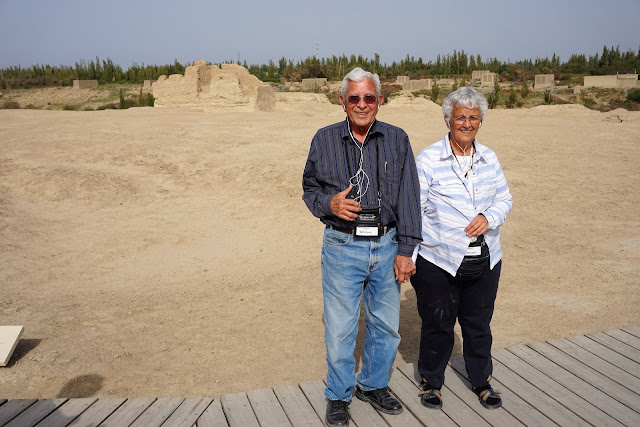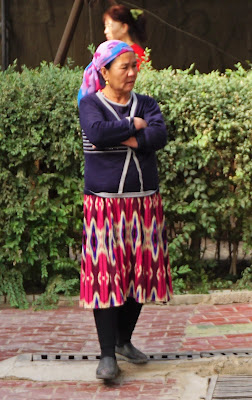We followed our morning visit to the ruins of Gaochang with a visit to the ruins of the ancient Silk Road city of Jiaohe, also known as "Yar City" because of its location in the Yarnaz Valley. Like Gaochang, Jiaohe sprung up in about 100 BC and was deserted around 1400 AD.
One of the things that makes Jiaohe so unique is its location on a plateau that rises 98 feet between two branches of a river. The best image I have of that is this map from the site:
The island is about 1,000 feet wide and a mile long. The river on each side provides a natural barrier, so Jiaohe is not enclosed in walls as are most ancient cities.
Paved walkways lead to the ruins:
As in other places where ancient ruins still cling to the earth, I imagine what fun it would be for kids to wander at will along the almost spooky roads and among the skeletal remains of buildings:

Some of the rooms are underground . . .
. . . and required that we descend a modern staircase to access them:
Once down and inside the four walls, it was possible to imagine someone living or working or worshiping here:
When we got to this point, it really hit me how huge the city once was. During the Tang Dynasty (618-907 AD), Jiaohe had a population of about 7,000 people, many more people than my hometown:
Our intrepid octogenarian traveling companions were always smiling:
On our way out, we appreciated (but did not succumb to buying) some of the unique items for sale:
. . . that is, until we saw this fruit stand:
Bob bought a hami melon, which has the rind of a canteloupe and the shape of a watermelon, and had it cut up so that he could share it with people in our group:
It was yummy! (And check out that wicked knife):
Our next stop was the nearby Karez Canals. I wouldn't associate water with this area of China, so learning about the canals was fascinating. Water is obviously more abundant here than I thought:
. . . and, like everywhere else, there are plenty of tourist shops:
A sign told us, "The Karez project are composed of 5 components: underground channel, vertical shaft, outlet, open channel and water pond. This underground channel includes conveying channel and catch-water channel, and water pond also is named small reservoir."
Hmmmm.
Turpan became an important stop along the Silk Road because of its advanced water system described, although somewhat awkwardly, above. Material at the site told us the irrigation system here is 2,000 years old and one of the "three great ancient projects in China," ranking with the Great Wall and the Grand Canal.
First, our guide AJ showed us a map of the canals:
The diorama also showed how those canals were dug:
Signs in Chinese and Arabic were helpful (not):
It was incredible to think of the genius behind building this irrigation system:
There are 11,000 meters of canals, almost 7 miles, with the first well being almost 250 deep. Three hundred years after its construction, it is still producing an amazing amount of water: 16 gallons/second:
On our way out, we were admiring this statue of a woman and noted that she has three braids. AJ told us that three braids means she is "available." Odd numbers of braids are for single women, even numbers of braids indicate a married woman or a woman with a lover, and a woman with just one braid is a grandma.
Have I mentioned that almost ALL the toilets in this part of China are squat toilets? They call them "Eastern style" and our seated toilets "Western style." Occasionally we ran into one of these:
Age is relative, right? I felt very old around this Western option:











































The extent ruins in this area are amazing when you consider how old they are and how long they have lasted.
ReplyDeleteTo find water here is ingenious and amazes me. That woman looks very Westernized in her dress, but with a twist. Finally, I guess this is the one place where you want your souvenirs to say "Made in China."
ReplyDelete